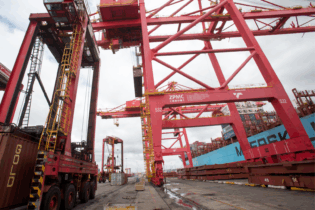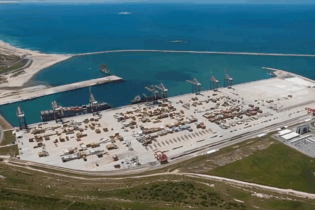Its tarmac littered with dozens of dilapidated planes, the airport in Congo’s capital Kinshasa makes clear the dire state of aviation even by Africa’s generally low standards.
The planes have been abandoned either as mechanical failures or by companies that went bust in a sector where a lack of proper infrastructure means pilots sometimes navigate with the help of Google Maps and sat-nav devices like those found in cars. “Crazy things happen here. We have to stop those crazy things happening,” says Frenchman Jean-Marc Pajot, who with his new FlyCongo airline is setting out to prove there is a market for those determined to make it work. On the face of things, it looks like a good business. An airline can charge $700 for a seat on the 1,600 km (1,000 mile) flight from Kinshasa to Congo’s copper mining centre of Lubumbashi. To fly a similar distance between London and Lisbon – and back – a ticket can be had for less than $100. With economic growth forecasts of around 7 percent until 2015 thanks to its mines, Democratic Republic of Congo’s business prospects look healthy alongside regional peers. Air passenger numbers more than tripled in the decade to 2010, growing nearly twice as fast as they did globally. But as in much of Africa, a spurt in growth after decades of decline has not translated into an improvement in infrastructure for airlines or anyone else. A lack of equipment that would be standard elsewhere, haphazard safety measures and challenging weather conditions make Congo one of the world’s riskiest places to fly. Last year Congo was behind only Russia with 111 flying fatalities according to the Aviation Safety Network, but Russia had some 30 times more passenger journeys. Only the much smaller African countries of Gabon, Sierra Leone and Djibouti scored lower in terms of overall safety in a survey by the International Civil Aviation Organisation. The background to Pajot’s FlyCongo could appear less than auspicious: it took over the assets of Hewa Bora, Congo’s largest airline until it lost its license last year when one of its planes crashed in a thunderstorm, killing 70 people. Pajot has already broken up six planes for scrap to streamline the company and as a gesture of its commitment to safety. He has five planes left. Pajot complains that airports don’t even have proper control towers: his staff go out to runways with walkie-talkie radios to give the pilots a picture of landing conditions. Another new airline, Korongo, in which Lufthansa subsidiary SN Brussels is a partner, has put some $3 million of its $12 million investment into infrastructure – going as far as to pay for airport firefighters. The need for a functioning aviation network is clear in Africa’s second largest country. It has hardly any roads. BY AIR OR … CANOE? Pilot Hugues Gendre recalls taking one priest to his parish deep in the equatorial forest in little over an hour, a journey which previously took 10 days and 10 nights of non-stop travel by canoe. But Gendre, who flies aid workers around, is skeptical a safe and viable airline can run in Congo. “Firstly there’s a lack of competence, then there’s also the phenomenon of generalized corruption, and there’s no strong central government,” said Gendre, president of Aviation Without Borders, a non-governmental organisation. “Little by little, training erodes, standards go down, and it ends in an accident.”President Joseph Kabila lost his closest adviser in February when the plane carrying him overshot a runway.
To support peacekeepers in the far reaches of a country the size of Western Europe, the United Nations operates its own air service. Many diplomats are barred by their embassies from using Congolese airlines. The government has resolved to reverse decades of mismanagement, said Emile Bongeli, who heads the state organisation which runs Congo’s airports. Runways are being redone and a national communications system is being set up. Longer term, Congolese airlines seek their removal from U.S. and European safety blacklists so they can fly the foreign routes that mining companies use to bring in staff and equipment. But there is no sign of that happening soon. “It’s not going to stop us working to improve security,” said Bongeli. Foreign airlines currently link Kinshasa with Europe and also fly from Lubumbashi to the African hubs of Nairobi and Johannesburg. Air France, which has four flights a week to Paris, said it was looking at Congo as a long term growth market. For decades, Congolese aviation has been tarnished by short-lived airlines that were sometimes founded more for laundering the proceeds of corruption than as profitable enterprises. The new operators are setting out to be different. For most of his career, Pajot, 52, was a manager in the information technology sector, although he spent the past three years as a commercial pilot and flight instructor. His airline flies to five Congolese cities from Kinshasa. “We have to go by the book,” he said. “I love big challenges, and this is certainly a big challenge.” The other start-up – the Korongo joint venture of SN Brussels and Congolese company Malta Forrest – has put its planes under the oversight of Belgian authorities to try to tackle the foreign safety concerns. Korongo chief executive Christophe Allard believes operating to international standards will encourage local companies to follow suit. Korongo flies between Kinshasa, Lubumbashi and Johannesburg. Despite the difficulties of navigating Congo’s politics – Korongo’s launch was blocked for more than a year because of internal wranglings – Allard believes the government is catching on to the need to improve the sector. “We told the Congolese that the game is over, that they have to accept modernity,” he said. “Now they can prove they’ve chosen to move in the right direction.” Source: http://www.reuters.com







